Using the Kano Model to Drive Product Success
14 October 2025 - Kirsty Simpson

Kano Analysis is a quantitative product development tool that helps teams assess how potential new features might impact customer satisfaction and loyalty.
Developed by Japanese economist Noriaki Kano, the framework categorises potential features into five groups:
- Mandatory
- Satisfier
- Delighter
- Indifferent
- Rejector
Your product is made up of a unique set of these features - some that drive success, and others that might hold it back.
In this article, you’ll learn how these different feature types influence customer satisfaction and why understanding them is essential for making informed product decisions.
Future articles in this series will show you how to identify the categories in your own products through Kano analysis, and how companies leverage these insights to stay competitive in the real world.
Let’s begin by exploring what each category and category group means.
Features that add value
The positive Kano categories (Mandatory, Satisfier, Delighter) are the features that add value and drive customer satisfaction. They are the collection of features that your product must have to help it succeed.
Mandatory features
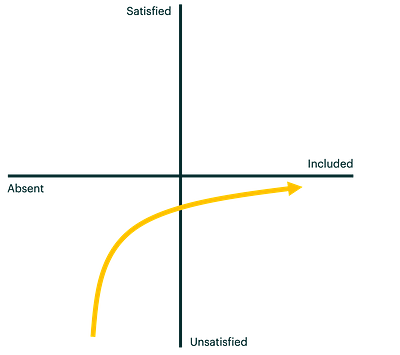
Mandatory features are the essential elements required to make a product viable and suitable for market entry. Users have come to expect these basic or operational features to be included in the product as a minimum.
Example: A smartphone is expected to have features like an on/off switch, call/text function, a camera and ‘Bluetooth’ connectivity (among many other things).
Think of mandatory features as the foundation for customer satisfaction. Once satisfied, they will create an environment where more advanced features (e.g. ‘Satisfier’ or ‘Delighter’ attributes that we will come on to discuss) can be introduced that will not just make your product competitive but will help it stand-out from the market.
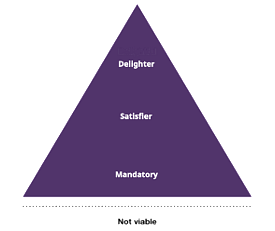
This concept mirrors Maslow’s ‘Hierarchy of Needs’: just as basic needs like food, water, and shelter must be met before higher-level needs such as connection or self-esteem, products must satisfy essential requirements before adding unexpected or delightful features.
Satisfier features
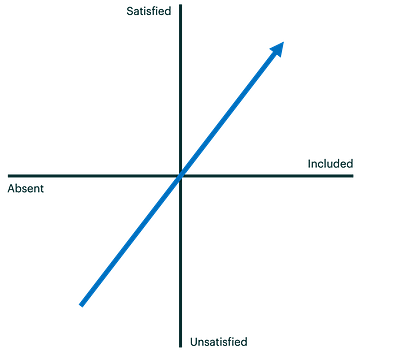
Satisfier features reflect what customers actively want. These are the features people look for when comparing products. They meet practical needs, like a high-quality camera or extra storage, and can also appeal to personal preferences or values, such as eco-friendliness or customisation options.
Customers weigh Satisfier features heavily when evaluating options, asking themselves: “Which product does what I need best”? or “Which one fulfils my needs better?”
Your product’s competitiveness often depends on how well you deliver the Satisfiers that matter most. Ultimately, customers will choose the product that offers the best combination and performance of Satisfiers features that are most important to them.
While Satisfiers are essential for staying competitive, they aren’t truly innovative. They help you keep up, but they don’t introduce anything unexpected. Most Satisfier improvements are incremental, aligning with market trends and technological advances. For example, customers expect smartphones to get faster, cameras to get sharper, and batteries to last longer. These upgrades, while valuable, don’t fundamentally transform the product experience.
Examples: High-quality camera specs, advanced security in a smartphone, file storage capacity, a sustainability or charitable ethos, options for customisation or personalisation
Considerations
There is an invisible limit to the number of ‘Satisfier’ features you can add
If your company has a large budget, it can be tempting to offer everything to customers. While adding more ‘Satisfier’ features can boost satisfaction, too many can clutter the interface and complicate the experience—sometimes called “experience rot.” It’s important to strike the right balance: offering enough features to delight users, while keeping the product clear and memorable so customers can easily answer, “What does this product do?”
To avoid experience rot, successful organisations focus on a few key features that are both valuable to users and manageable internally. For example, Shopify keeps its core product simple while allowing external developers to add a curated selection of custom ‘Satisfier’ features, making the platform both user-friendly and flexible.
Delighter features
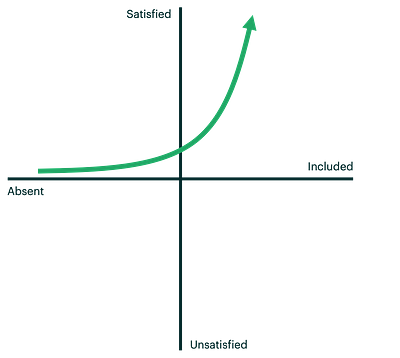
Delighters are the features that customers didn’t even know they wanted.
They are the unexpected and surprising features that users don’t anticipate, but once encountered, they stand out and create memorable experiences that increase brand recall and customer loyalty.
Delighters tend to be market differentiators, offering unique features that competitors lack. For example, new iPhone features often provide distinct value that helps Apple stay ahead of the competition.
Importantly, Delighters are innovative features. While some are radically innovative breakthroughs, others simply change how value is delivered—offering a fresh perspective, a playful twist, or a more engaging experience.
Examples
- Google introduced a simple, offline browser game that appears in Chrome when you try to access a website but there’s no internet connection, transforming a frustrating “no internet” moment into a light-hearted distraction. Even if not highly innovative, the unexpected and playful nature of the feature added delight and made the experience more enjoyable.
- Spotify surprised users with its “Wrapped” feature in 2016, which provides users with a personalised, year-end summary of their listening habits. While relatively innovative, it wasn’t a radical technological leap. However, it changed how users engaged with their own data—turning dry stats into a playful, shareable experience, and showed that even existing information, when reframed creatively, can become a powerful Delighter.
- Apple’s Face ID is a good example of a radically innovative Delighter that disrupted the marketplace — redefining phone security through facial recognition, solving a major pain point and transforming the user experience.
Considerations
Delighters are temporary, so you need to keep delivering them over time
Much like happiness, the experience of delight (that comes from Delighter features) is temporary and fleeting.
According to the ‘hedonic treadmill’ psychological model, humans generally experience short-term spikes in happiness or delight following unexpected positive events and interactions. Eventually, as we get used to that experience of delight, we get bored, and our levels of happiness or delight return to our pre-event state baseline.
.png)
The features that were once new and delightful to us, are now expected as standard and ‘good enough’ (much like when we get used to a new iPhone or smartphone model).
“People often remark on how quickly the extraordinary becomes commonplace… We are highly adaptive creatures. The predictable becomes, by definition, background” — Author, Ian McEwan
Then, we seek more. The next wave of delight. The next emotional high or dopamine hit. It’s in our nature.
It’s so important to keep delivering new delighter features over time, not only because users will keep chasing these emotional highs, much like surfers seek waves, but because offering something innovative or different gives companies a competitive edge – at least until another delighter emerges or disrupts the market.
Delighter features mean nothing when you haven’t satisfied your lower order features
Mark Hoplamazian, the former CEO of Hyatt, once launched an ambitious program called ‘Random Acts of Generosity’. The idea was to surprise guests with unexpected perks like free massages and room upgrades, aiming to leave them deeply grateful (a potentially profitable emotion that can lead to increased loyalty).
However, the program didn’t succeed because these ‘delighter’ perks held little value when the core Hyatt experience was lacking. Issues like poor room service or malfunctioning air conditioning overshadowed the pleasant surprises.
The failure of Hyatt’s program underscores that you must address the fundamental needs and expectations of your users before they can appreciate any additional delights. Again, reminiscent of Maslow’s hierarchy of needs, basic (Mandary and Satisfier) needs must be met before higher-order aspirations can be pursued.
Delighter features often become mandatory features in time
As users become accustomed to delighter features and return to their baseline of customer satisfaction, their expectations shift. What was once an exciting surprise, becomes a standard expectation. Users begin to take these features for granted and expect them in future products. In essence, ‘Delighters’ will, in time, become mandatory features or basic expectations for a product.
‘Delighters’ becoming ‘mandatory’ features reflect the nature of innovation, where basic expectations for services incrementally increase over time as result of changing societal values and technological advances.
With this in mind, we need to constantly monitor when ‘Delighter’ features become the new normal, and where we need to make room for innovation so we don’t get left behind in the marketplace.
Features that negatively impact value
Negative Kano categories (Indifferent, Rejector) don’t add value — or worse, actively drive customers away.
Indifferent features
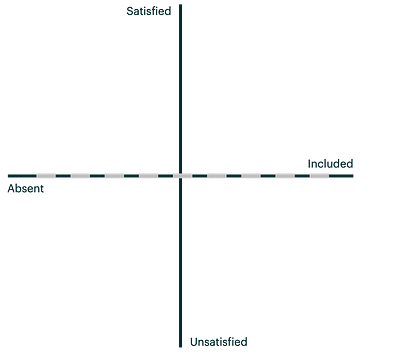
‘Indifferent’ features are features that neither enhance nor detract from customer satisfaction — customers just feel neutral about them.
As indifferent features don’t deliver value, they will clutter your interface and will worsen the experience as a result.
Example: A set of toolbar icons in an application that most users do not use or find redundant.
Rejectors
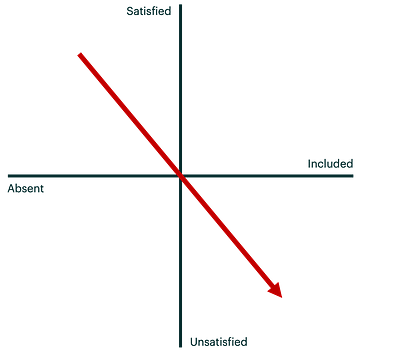
Rejector features actively cause dissatisfaction when included in a product. Customers don’t just tolerate these, they dislike them, and they’ll tell you about it.
That’s why it’s crucial to identify Rejectors early as otherwise they can erode customer trust, damage the user experience, and ultimately push customers toward competitors.
Example: Frequent and disruptive pop-up advertisements in a free app that interrupt the user’s primary activities.
What next?
Now that we’ve introduced the Kano Model categories - Mandatory, Satisfier, Delighter, Indifferent, and Rejector - we can see how different features shape your product’s success. As we’ve learned, each plays a distinct role, from meeting basic expectations to creating moments of surprise and delight.
But understanding these categories is just the start.
In the next article of this series, we’ll explore how companies regularly assess and leverage Kano insights for marketplace success. Specifically, how they strategically use these categories to stay competitive and deliver lasting value.
Later, we’ll guide you through how to run a Kano analysis on your own potential feature set—step by step, so you can make confident, customer-focused decisions that drive product success and retain it over time.
You might also be interested in...
Bridging Business Analysis and User Experience: Achieve Outstanding Digital Results
24 November 2025Discover how aligning Business Analysis and User Experience transforms digital projects - boosting efficiency, user satisfaction, and ROI for organisations seeking exceptional results in today’s competitive market.
Read the article: Bridging Business Analysis and User Experience: Achieve Outstanding Digital ResultsMaking Hospitality Welcoming for All: A Digital Accessibility Guide for Hotels
21 November 2025Hotels have long focused on physical accessibility, but true inclusion extends online. This practical guide explains how to make your hotel website accessible for all guests—meeting global WCAG and EAA standards, expanding your reach, and creating a seamless booking experience for every visitor.
Read the article: Making Hospitality Welcoming for All: A Digital Accessibility Guide for Hotels3 perspectives on how AI is shaping inclusive digital experiences
10 November 2025AI is transforming digital accessibility — empowering disabled users, enhancing how we evaluate digital experiences, and reshaping how inclusive products are designed. This article explores three key perspectives and highlights how AI can support more equitable, human-centred digital experiences when used thoughtfully and collaboratively.
Read the article: 3 perspectives on how AI is shaping inclusive digital experiences